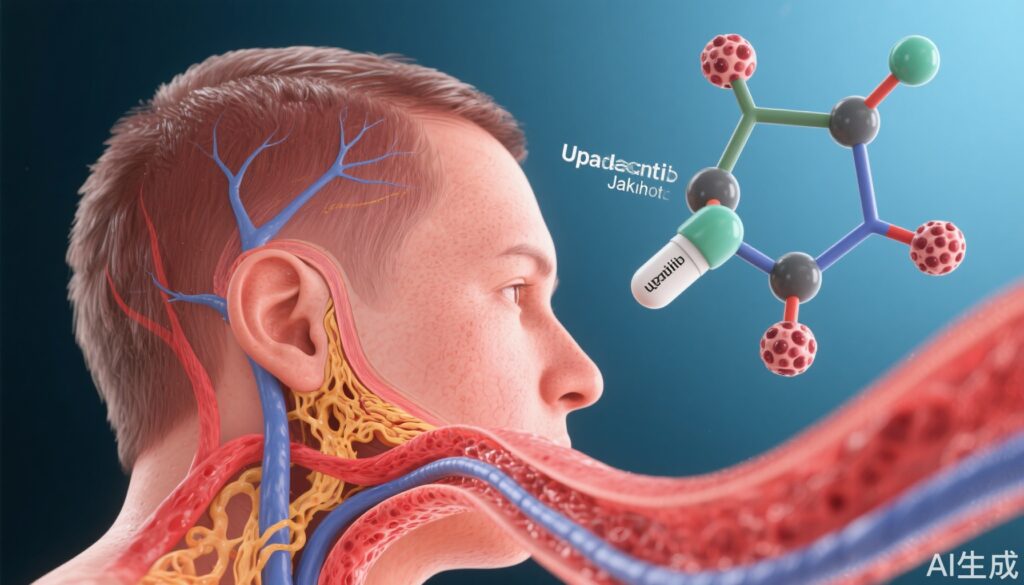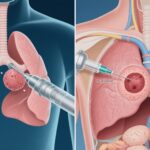Highlight
1. Upadacitinib 15 mg daily plus a 26-week glucocorticoid taper significantly improves sustained remission rates in patients with giant-cell arteritis (GCA) compared to placebo with a 52-week taper.
2. Upadacitinib 7.5 mg does not demonstrate superior efficacy over placebo.
3. Safety profiles of upadacitinib and placebo are comparable over 52 weeks, with no major cardiovascular events observed.
4. Real-world evidence supports the potential effectiveness of Janus kinase inhibitors (JAKi), including baricitinib, tofacitinib, and upadacitinib, in relapsing GCA, even in patients failing prior immunosuppressants and biologics.
Clinical Background and Disease Burden
Giant-cell arteritis is a systemic vasculitis predominantly affecting adults over 50 years, characterized by granulomatous inflammation of medium and large arteries, especially the temporal arteries. It can lead to severe complications such as vision loss and stroke. Current treatments rely heavily on prolonged glucocorticoid therapy, which carries substantial morbidity due to adverse effects. Tocilizumab, an interleukin-6 receptor inhibitor, is approved but not universally effective or tolerated. There remains a critical unmet need for additional glucocorticoid-sparing agents with favorable efficacy and safety profiles.
Research Methodology
The SELECT-GCA trial was a randomized, double-blind, placebo-controlled phase 3 study assessing upadacitinib, a selective JAK inhibitor targeting cytokines including interleukin-6 and interferon-γ. Patients with new-onset or relapsing GCA were randomly assigned (2:1:1) to receive upadacitinib 15 mg or 7.5 mg once daily plus a 26-week glucocorticoid taper, or placebo plus a 52-week taper. The primary endpoint was sustained remission at 52 weeks, defined as absence of signs and symptoms of GCA from week 12 through week 52, alongside adherence to the protocol-specified glucocorticoid taper. Secondary endpoints included complete remission, time to flare, cumulative glucocorticoid dose, and patient-reported outcomes.
Complementing this, a retrospective real-world study analyzed 35 patients with relapsing GCA treated with JAK inhibitors (baricitinib, tofacitinib, upadacitinib) across 14 centers (Spain and USA) from 2017 to 2022. Outcomes included clinical and complete remission and safety. A systematic literature review identified additional JAKi-treated GCA cases.
Key Findings
In the SELECT-GCA trial, 209 patients received upadacitinib 15 mg, 107 received 7.5 mg, and 112 received placebo. Approximately 70% had new-onset disease. Upadacitinib 15 mg achieved a sustained remission rate of 46.4% (95% CI, 39.6–53.2), significantly higher than placebo (29.0%; 95% CI, 20.6–37.5; P=0.002). Upadacitinib 15 mg also outperformed placebo in key secondary endpoints: sustained complete remission, delayed time to flare, reduced cumulative glucocorticoid exposure, and improved patient-reported outcomes. The 7.5 mg dose did not show superiority over placebo (41.1%; 95% CI, 31.8–50.4). Safety profiles were similar between upadacitinib and placebo over 52 weeks, with no major adverse cardiovascular events noted despite theoretical JAKi-associated cardiovascular risks.
The real-world study of 35 patients (86% female, mean age 72.3 years) with relapsing GCA demonstrated that 57% achieved and maintained clinical remission, and 46% achieved complete remission after a median follow-up of 11 months. Notably, 63% had previously received conventional immunosuppressants, and 86% had been treated with biologics such as tocilizumab. Discontinuation occurred in 43%, mainly due to relapse or serious adverse events. The literature review of 36 additional cases corroborated clinical improvements with JAKi therapy.
Mechanistic Insights and Biological Plausibility
JAK inhibitors, including upadacitinib, modulate signaling pathways of multiple pro-inflammatory cytokines implicated in GCA pathogenesis, such as interleukin-6, interferon-γ, and others. By selectively inhibiting JAK1, upadacitinib attenuates the aberrant immune activation driving vascular inflammation. This mechanistic rationale supports the observed clinical efficacy in inducing and sustaining remission and reducing glucocorticoid exposure.
Controversies and Limitations
While the phase 3 trial provides robust evidence for upadacitinib 15 mg, the lack of efficacy at 7.5 mg dose raises questions regarding optimal dosing and balance between efficacy and safety. The trial’s glucocorticoid tapering regimens differed in duration between arms, potentially influencing outcomes. The 52-week treatment and follow-up period may be insufficient to capture long-term safety signals, particularly concerning cardiovascular risk and malignancy. The real-world study’s retrospective design and relatively small sample size limit generalizability and preclude causal inference. Additionally, heterogeneity in prior therapies and JAKi agents complicate direct comparisons.
Conclusion
The SELECT-GCA trial establishes upadacitinib 15 mg daily plus a 26-week glucocorticoid taper as an effective and generally safe treatment option for patients with giant-cell arteritis, offering superior sustained remission rates compared to placebo with a longer glucocorticoid taper. Real-world data complement these findings, suggesting that JAK inhibitors may be a promising therapeutic alternative for relapsing GCA, including cases refractory to standard immunosuppressants and biologics. Future research should focus on long-term safety, comparative effectiveness, and personalized treatment strategies.
References
1. Blockmans D, Penn SK, Setty AR, et al. A Phase 3 Trial of Upadacitinib for Giant-Cell Arteritis. N Engl J Med. 2025;392(20):2013-2024. doi:10.1056/NEJMoa2413449.
2. Loricera J, Tofade T, Prieto-Peña D, et al. Effectiveness of Janus Kinase Inhibitors in Relapsing Giant Cell Arteritis in Real-World Clinical Practice and Review of the Literature. Arthritis Res Ther. 2024;26(1):116. doi:10.1186/s13075-024-03314-9.


